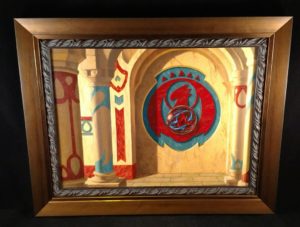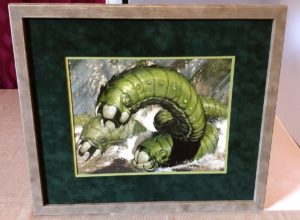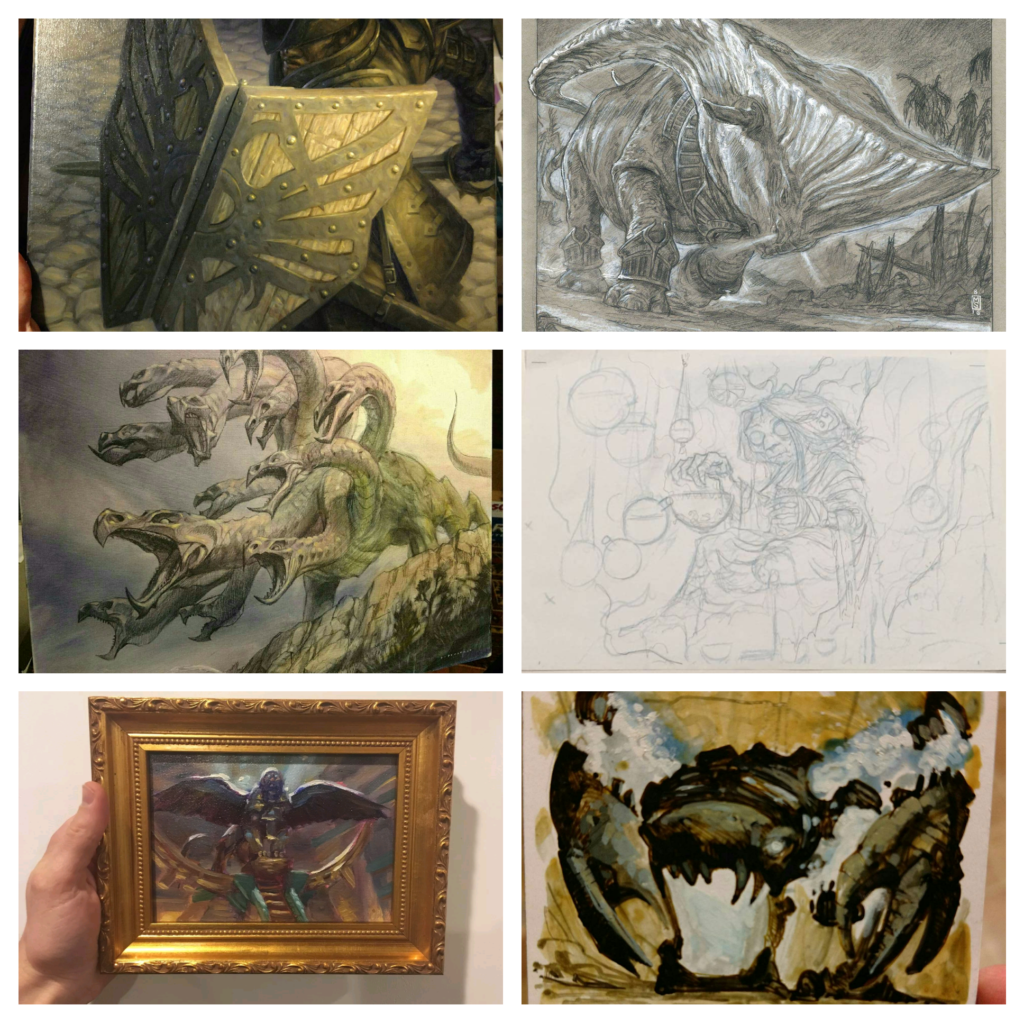Howdy folks, and welcome to The Mirror Gallery here on Hipsters of the Coast!
My name is Donny Caltrider, I’ve played Magic since Onslaught in 2002, and for the last year have collected original Magic: the Gathering artwork. During that time I have taken the deep dive into the world of being a Vorthos, flavor, and all the things that surround Magic outside of the game itself. The first glimpse into my Magic art collection was over on the Original Magic Art Blog. If you missed it, you can find it here.
In that “Collector’s Tale” I told the art collecting community I had acquired and framed Izzet Cluestone by Raoul Vitale and Crush of Wurms by Christopher Moeller, and was laying low in terms of buying anything until Illuxcon, the largest gathering of imaginative realism artists, collectors and students in the country, in October of 2017.

Izzet Cluestone, Raoul Vitale, Oil on Board, Dragon’s Maze, 2013

Crush of Wurms, Christopher Moeller, Acrylic on Illustration Board, Judgement, 2002
Illuxcon has come and gone, and what a sensory overload it was in all the best ways. I saw some incredible art, met some great people, and got to speak with some amazing artists over the few days I was there. I even bought a new piece for my collection, which you will see in an upcoming article.
I really enjoyed writing about my collection during my first Original Magic Art story, and have decided to go a bit deeper into the pieces in my collection. This is where it will call home, so welcome! My plan is to post at least one “major” collection piece a month, with some other art collecting or Vorthos goodness in between. My background is in decorative arts (functional yet beautiful objects) and museum studies, and I absolutely love talking about “things” and the stories they can tell. Whether it’s a painting, a piece of glass, a silver spoon, or a collectible card, everything has a story so long as someone is willing to tell it.
Here we will look at my personal collection of original Magic art, the artists behind the works, what they mean in the larger body of Magic, and my motivations for acquiring them. There will be lots of words, but plenty of images too. One of the parts of each article will be looking into my collection motivations, and breaking each piece down into Five Things to Consider when Looking at Original Magic: the Gathering Card Art. They are:
1. Do You Love It?
When it comes to buying original Magic art, the collector is the one that will be living with the piece for the foreseeable future. Buy something because you love it, whether it’s the work itself, the story behind it, a particular memory it holds, a fondness for the artist, etc. There’s nothing wrong with buying something because it’s a good deal or there is future value—I do it too—but generally buying what you love will leave you much happier. Promise.
2. The Work

Mediums/Stages of Magic Art (Clockwise from top left): Final Oil on Canvas, Final Pencil Sketch, Preliminary Blue Line Sketch, Artist Proof Color Sketch, Color Study, Preliminary Color Study (large)
Magic art comes in all forms, shapes, sizes, and mediums. so you have to decide what you’re interested in, and where that fits in the overall landscape of the market. Everyone has preferences towards some artistic styles over others, and some style guide aesthetics over others. Look at everything: see what you like, and see what others like too. There is a lot to discover. We will look at all these different types over the course of this column.
3. The Artist
There are thousands of artists that have illustrated a Magic card, with more joining the ranks literally every set. Many times Magic illustration is just a portion of an artist’s larger body of work and where their work resides in the larger genre of sci-fi/fantasy. Some artist’s work move one step further to imaginative realism, where the fantastic and magical are portrayed as if in a real world. Do some homework: learn about artists, their styles, what they have done, and what they are going to do next. Talk to them if you’re able. You’ll learn a lot.
4. The Card
The card as it exists in the game plays into a lot of collecting decisions. There are a lot of unplayed or marginal cards with really great artwork, and sometimes their art goes uncollected or for considerably less because of this. There are also a lot of cards that led players to National, Pro Tour, and World Championships, and this will boost prices and desirability of their artwork based on the card’s performance. You need to be aware of the relationship of art and card, even if it doesn’t impact your personal collecting decisions.
5. The Environment
There are two parts to this: the play environment and the set environment. If a card is or was well loved or used in a format, from Standard or Commander, there are going to be considerably more people interested in acquiring the art. In the same way, some sets hold a very special place in Magic history, and therefore they are more popular and desirable for collectors, (here’s looking at you Lorwyn/Shadowmoor). This does not necessarily mean the piece will be more expensive, but it does mean there will be competition. Again, even if these things are not a factor in your decision making, you need to be aware of them because they do affect the market that you are navigating.
The Sofa Test
I may also occasionally talk about the Sofa Test—or the Significant Other Factor—whether the piece is appropriate for hanging over your sofa in the living room. Originally written about by Josh Krause over on Original Magic Art, it really boils down to how your collection of art exists outside the confines of what you, the collector, personally like and dislike.
Some of my collection passes the Sofa Test with flying colors, and while the majority of it does not hang in the house outside of my office, the possibility remains as I expand my collection. Other pieces are best off staying where they are.
To scratch the surface, its why lands and cards with large landscapes, for example, tend to be more highly collectible. It’s much easier to hang a sunset landscape or majestic treefolk in your living room than a hulking demon or goblin being split in two, if you catch my drift.
Wrapping Up
I have a variety of pieces in the hopper that we can deconstruct together, and over the next few months we will look at everything from Magic sketches to color studies to finished traditional works, and maybe even an Artist Proof or two. I’ll also talk about each of these as collecting options and where they fall into the larger hobby.
The next time you hear from me we will be taking a look at that piece I picked up at Illuxcon, which was the third piece overall I added to my collection. We will explore the artist, the work itself, and where it fits into the Magic landscape. We will even take a look at the frame and where framing falls into the collecting hobby.
I’m certainly glad that you have joined me on this ride to just begin to scratch the surface. To see original #mtgart and other #vorthos related things, follow me on Twitter. Feel free to ask questions or retweet to continue the conversation. Thanks and see you next time!
Donny Caltrider has been playing Magic since 2002 and collecting original Magic art since 2017. He has an M.A. in Museum Studies from Johns Hopkins University and enjoys telling stories about art, objects, and the intersection of fantasy with real-life. You can find him on Twitter talking about #mtgart, museums, and other #vorthos related goodness. Follow along and continue the conversation!

